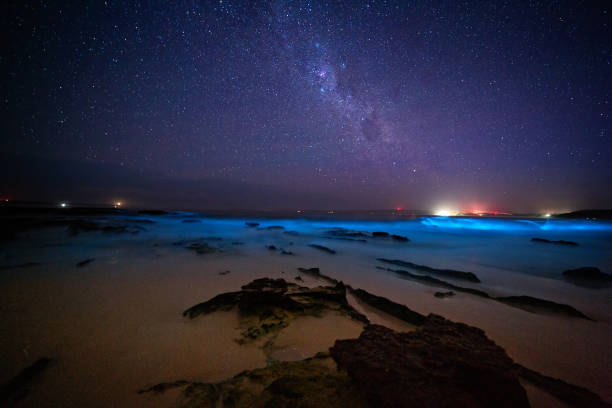Bioluminescence is a special natural phenomenon where the sea surface emits a blue fluorescence, creating a dreamlike scene that is truly stunning. As the waves gently wash upon the shores, they bring forth waves of luminous light, creating a sparkling and beautiful spectacle!
So what months can you see Bioluminescence?
In Tasmania, if you’re lucky, you can witness this wonder at any time of the year, with a higher likelihood during the warmer months. Walking through the fluorescent waters, running your hand across the surface, feels like creating a “Milky Way” under a vast starry sky while your feet are embraced by the glowing sea waves. It’s truly a romantic experience!
Here are a few of Tasmania’s beaches where you can easily spot Bioluminescence
Preservation Bay
This 700-meter-long beach winds its way between low rocky cliffs. Beyond the beach lie sand dunes and an old road. All drivers travelling on this old highway can enjoy the scenic beauty of the beach. When night falls, taking a leisurely stroll on the beach while the sea breeze ripples the surface, revealing faint starry blue lights, is a magical experience.
Kingston
Kingston Beach is located in a small town on the outskirts of Hobart, Tasmania, nestled between a few small hills about 12 kilometres south of the city. It was originally known as Browns River Beach in the 1850’s. Kingston boasts beautiful scenery, making it not only a popular spot for photography but also a great place for surfing. At night, you might even catch a glimpse of the fluorescent waves as you surf!
Goats Bluff
Goats Bluff, situated in South Arm, is an irregular 500-meter-long, 30-meter-high sandstone cliff that separates Calverts and Hope Beach. You can visit the lookout to admire the fluorescent sea, or if you want a closer encounter, head directly to the beach. The beach’s scenic beauty is truly delightful to behold.
Bioluminescence Photography Tips
For Mobile Phones: Use long exposure settings.
For Cameras: Aperture of F2.8 or higher, F4.0 works too; increase exposure time as needed.
Tripod: Nighttime photography in low light conditions, plus the sea breeze, calls for a tripod to ensure clear and sharp images.
Other Equipment: Non-slip shoes, a jacket, waterproof bags for phones, flashlights/headlamps.
Additional Tips
- Check local weather forecasts and tide conditions in advance.
- Some scientists suggest that nutrients from rainfall may serve as “food” for bioluminescent algae in the seawater. Therefore, the best time to spot Bioluminescence could be after a period of rainy weather followed by clear skies.
- Join the “Bioluminescence Australia” group to stay updated on real-time Bioluminescence information.







